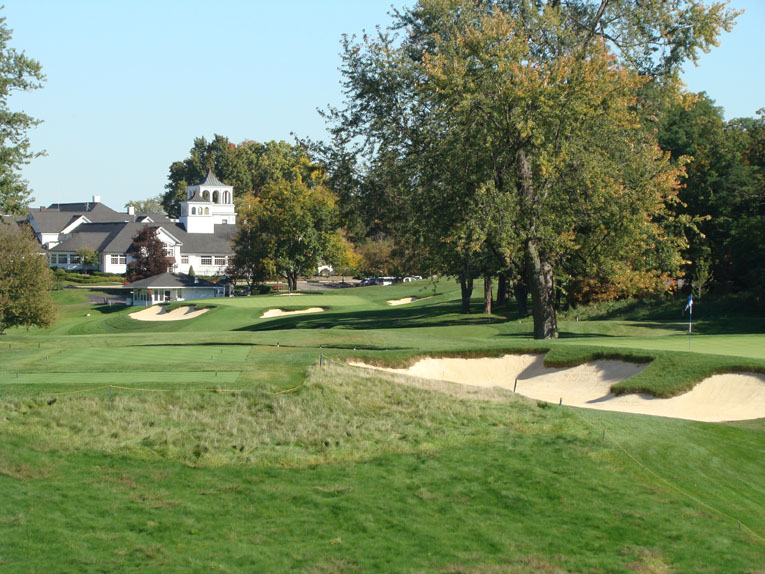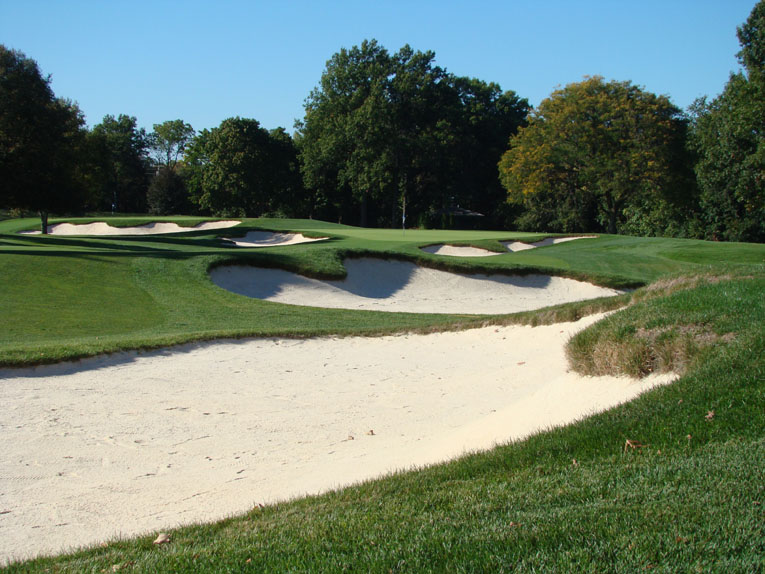Orchard Lake Country Club, MI, USA
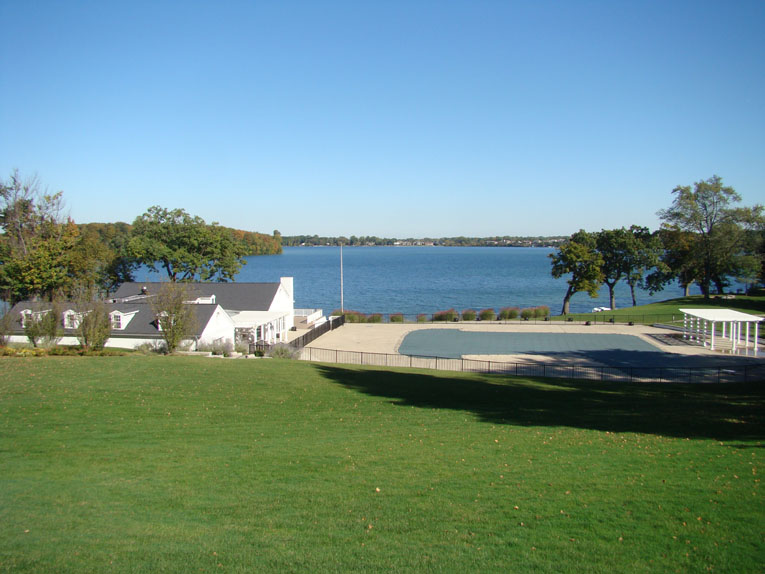
Regardless of this view from the club porch to the east over its pool house and swimming pool toward Apple Island, the best thing about Orchard Lake Country Club …
Gene Sarazen, Sam Snead, Arnold Palmer and Gary Player all had kind words for Orchard Lake. No surprise really, Captain Hugh Alison, one of the all time great architects, designed it during the Golden Age of architecture. Built over roly-poly land of human scale, the raw property allowed Alison to carve some of his famously deep bunkers into the folds and take advantage of many natural green sites.
Over time Alison’s design faded, many of his features were softened and by 1990 Orchard Lake had lost its standing in the top tier of Detroit courses. It had fallen prey to the usual malady: five decades of overzealous tree planting. Tree encroachment is both slow and insidious. As woodlands expand, fairways shrink and bunkers are removed when their position becomes irrelevant. Nothing to guard down an avenue of trees! Trees also stunt air movement and typically lead to soft, spotty playing conditions. Regardless of its pedigree, no course can survive unchecked tree growth.
In 2002, Orchard Lake made a fortuitous call to Keith Foster. Unknown to the club at the time, Foster had traveled across the breadth of England in the late 1990s studying the works of Fowler, Colt and Alison. While most architects look to Scotland or Ireland for inspiration Foster found the allure of England irresistible. Upon his return stateside, Foster, an antique collector, stumbled on a Frank Hopkins 1927 limited edition book that featured great holes around New York City. It captivated his imagination particularly, the drawings of several holes at Alison’s Lakeville (Fresh Meadow, today) on Long Island.
Foster’s own field research and these drawings convinced him that most Alison courses had become diluted, weakened versions of his original work. According to Foster, Harry Colt’s work can be characterized as subtle, charming and understated. Alison tended toward bolder features in part to differentiate himself from his partner. His green pads were every bit as huge as Seth Raynor’s but his bunkering underneath them was more artistic. Working backwards from the green pads, which Foster affectionately refers to as ‘monuments to the ground’, Foster admires Alison’s sculpted bunkers, randomly cut into landforms and the low lying nature of Alison’s tees.
Given time and money, most clubs inadvertently emasculate Alison’s work. They build up his tee pads, narrow the scale of his holes and features and diminish the stature of his green complexes with extensive rear plantings. Such was the state of Orchard Lake when Foster took his initial walk around the property in 2002. Over a series of meetings, Foster communicated his vision, a restoration of the grandeur of Alison’s work. Foster’s infectious enthusiasm for Alison and his place in the game as one of the elites carried the day. His plan was accepted in 2003 and the first order of business was the intelligent removal of non-indigenous trees. In Green Keeper Aaron McMaster, Foster had the perfect cohort who shared a common vision. According to McMaster, who joined as an Assistant Green Keeper in 1996, ‘From the moment I saw the club I loved the layout, land and greens. You could see the bones were great but it had been overplanted during the 60’s and 70’s especially with Norway Maples. The problem these trees presented was that they totally obscured the great rolling terrain the club possessed, obliterating long vistas that are another signature of the property. There were only a few minor alterations to the course that would be difficult to reverse; mainly greens 2, 4, 8, 12 and 15 that had been rebuilt in the 1960’s. Otherwise, all renovations were minor in nature such as the removal of bunkers and a few strange tees that just didn’t fit it. It was very much an Alison course yearning to be brought back.’ McMaster and his crew slowly but surely started pulling back the growth, exposing a delicious, rolling landscape.
The conundrum is that tree removal is both essential and contentious. Ultimately, any project moves at a pace with which the club is comfortable. At Orchard Lake important strides were made in the first couple of year but just when the club was about to head into phase two, bunker restoration, economic conditions intervened. The automotive sector, Detroit’s backbone, was hard hit in 2007 and the rest of the American economy suffered a severe body blow the following year. The re-introduction of many of Alison’s features was delayed and finally carried out in the fall of 2011 and 2012.
With the trees down, the course went from 22 acres of fairway to 35. 22 bunkers were restored, raising the total to 68 (a 48% increase). Most importantly, the bunker footprints were significantly enlarged and there is a whopping 250% (!) more exposed sand today than ten years ago. Even relative to other Golden Age architects like Donald Ross and A.W. Tillinghast, the scope and size of Alison’s bunkers are a standout feature. No such thing as a proper Alison course without his trademark bunkering.
McMaster notes:
It was at this point that we put back all the bunkers both from the original course and added a few in the Alison style based on where people hit it today. The bunkers needed to be grand like Alison’s other works and they needed to fit the scale of the property. The existing bunkers had shrunk and the land just dominated them. We stepped up the tree removal and also made a major gain with the addition of 27 acres of native fescue. We always thought that the native would do very well with our sandy dry soils and that the maintenance crew could keep them thin and playable. These areas were previously planted with bluegrass areas that didn’t show off the land forms. The board and membership saw this transition in grasses as best environmentally, architecturally, aesthetically and economically. Regarding bunker styles, we ultimately chose one that Keith likes to call Alison with a little more edge. We wanted to have the eyebrows of the bunkers be fine fescue and leave them rough for an old school look and natural tie in with the native areas. Keith approved this and that is how our bunkers evolved to look as they do.
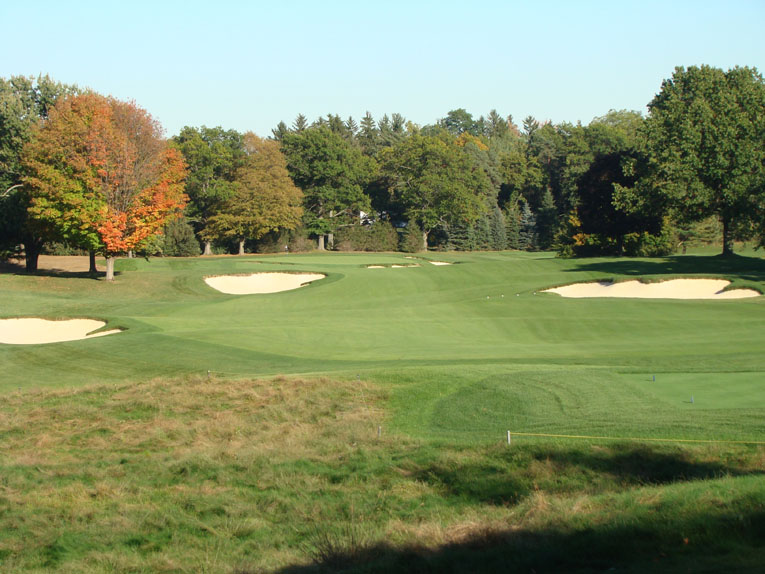
Look how artistically the bunkers are cut into land down the fourteenth fairway. This picture in 2002 would have shown just four bunkers, all greatly reduced in size, and the hole exhibited little of the charm that it does today.
In addition, natural bowls and other topographic features were brought back into play. Tee balls now slalom along the second fairway, are shunted into the restored bunker off the tee at the eighth, and tumble along the fourteenth and fifteenth fairways. A big bowl is once again found within the twelfth fairway as seen below. Golfers now appreciate the movement of the ground at Orchard Lake both visually and from a playing perspective.
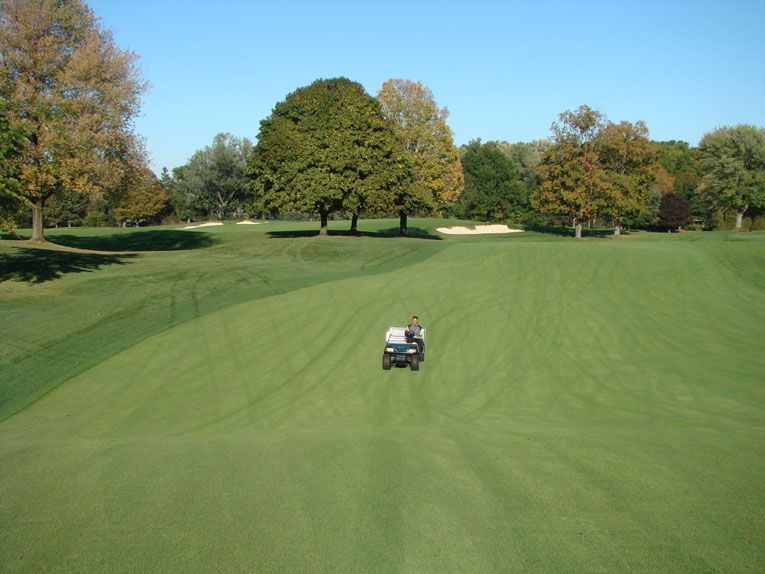
Looking back down the twelfth fairway, McMaster’s cart denotes the rough line in 2002. This wonderful bowl is an example of a unique feature that once was lost and is now found.
Foster approaches each restoration project in its own measured way. That is important because Alison himself had devoted a good deal of time and nuanced this design. During the winter of 1926 he spent nearly 30 days surveying the 140 acres that became Orchard Lake. In the spring and summer of that year, Alison was on-site almost sixty days during construction. In the Golden Age of golf course architecture that was a considerable amount of time; it still is! LW Lavis from New York was the on-site supervisor.
Holes to Note
(As part of the restoration, back tees have been added and this par 71 course can play over 7,100 yards. The yards cited below are from the 6,700 yard Gold tees which will tax all but the very best.)
First hole, 390 yards; While Orchard Lake doesn’t possess a rushing river like some of Alison’s other U.S. designs, it has roly-poly landforms across its entire 140 acres. Only at the first and ninth fairways are the odds of drawing a level stance in the golfer’s favor. Every other fairway features movement of six to eighteen feet, which is nothing short of ideal. The golfer can’t complain of hilliness and yet the variety of lies offered up ensures fresh golf from one round to the next.
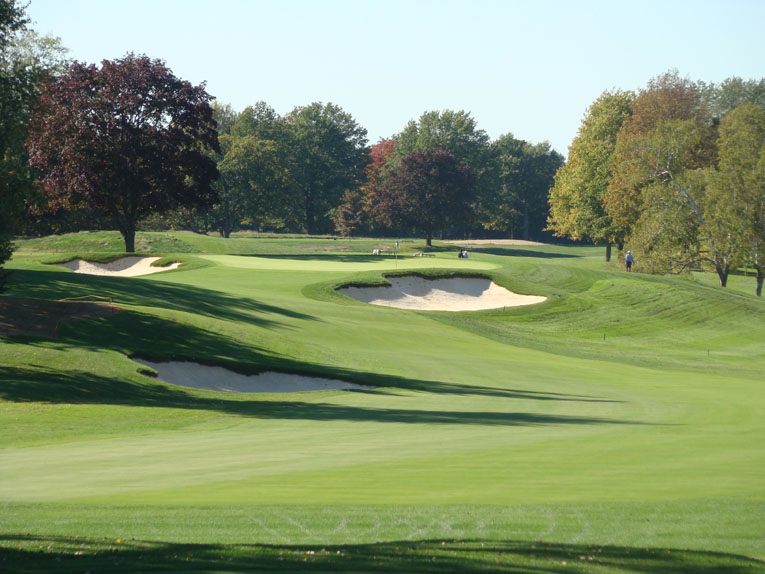
The good news is that the wide fairway offers up plenty of level stances for one’s approach. The bad news is …

… everything else! Who can blame the golfer for trying to avoid the yawning deep front bunker? Though more subtle in its terror, the pitched putting surface is equally worrisome.
Second hole, 480 yards; Orchard Lake was a regimented course ten years ago requiring little more than straight hitting down tree lined fairways. Such golf lacks beauty and stymies imagination and creativity, the very components that make Golden Age courses so cherished. Compare that restrictive linearity with the picture below of the free form second hole as it is now.
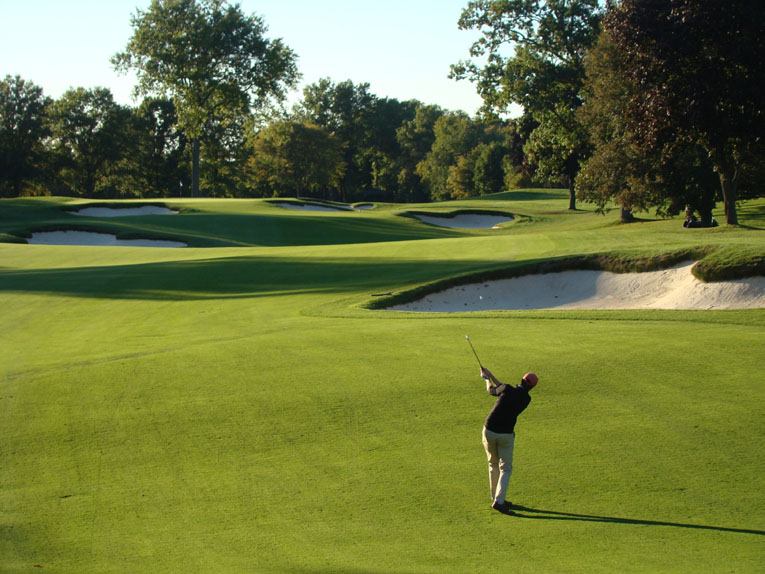
Today’s bunkering scheme heightens one’s appreciation for the free- flowing landscape that is Orchard Lake while providing all golfers with something to mull over. This golfer has a go for the green from 230 yards out, after having made the necessary adjustment in his stance for the uphill lie.
Third hole, 185 yards; Alison’s partner, Harry Colt was keen about first staking out par 3 holes. Whether Alison did the same is unclear as he left little documentation behind. Yet, Colt’s tendencies surely held some sway because Orchard Lake’s three shotters feature an uncommon amount of variety.
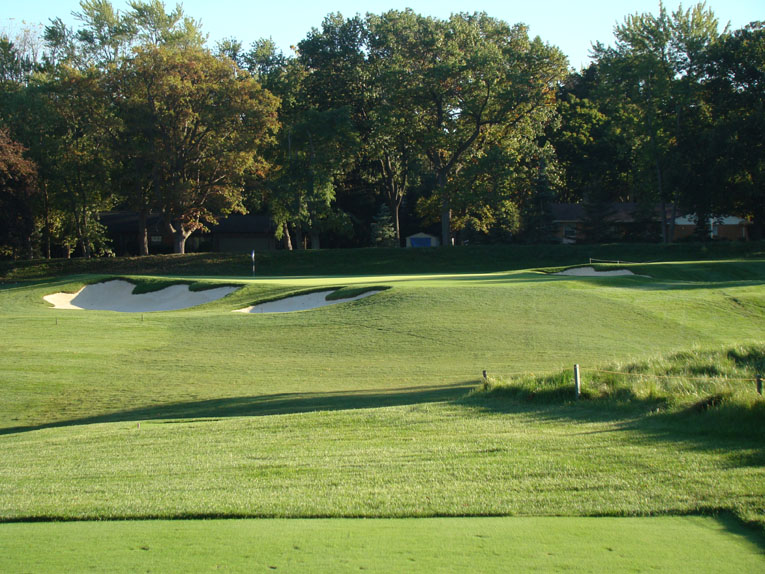
Classic features define classic courses and there are few more heart-warming sights for an architecture buff than this par three and its Redan characteristics.
Fourth hole, 370 yards; One’s round gets underway with three enticing holes, one of each par. Indeed, there are many fine three hole stretches throughout the course and gaining consensus among the members as to the best is impossible. However, not a single member would nominate the fourth through the sixth. More work is to come here but the reverse fairway bunkers looking at each other at the fourth and the sixth’s kettle depression that will be full of swaying fescues in 2014 speak to the overall quality of the course. There is not a clunker hole in the lot.
Seventh hole, 220 yards; As long as big one shotters are built to scale, the author has always found them to be prized holes. The ninth at Yale, the twelfth at Wannamoisset, and the thirteenth at The Addington are examples that add variety and drama to their respective courses. This one does too.

Foster is a big fan of the seventh because it epitomizes the grand scale that Alison favored. The mammoth left bunker is the largest on the course and dwarfs the golfer.
Eighth hole, 390 yards; One of the prettiest holes in a golf rich state, the eighth plays as well as it looks. Though its corridor is essentially straight, playing angles abound. Two fairway bunkers scream at the golfer to hit the tee ball left but the deep, 30 yard long left greenside bunker suggests otherwise.

The perfect line off the tee is slightly left of the gentleman holding the flag stick. If well struck, the tee ball carries the forward bunker, kicks off the downslope beyond, and stays short of a second fairway bunker seventy yards ahead. The golfer is rewarded for the bold line off the tee with a short iron into an open green.
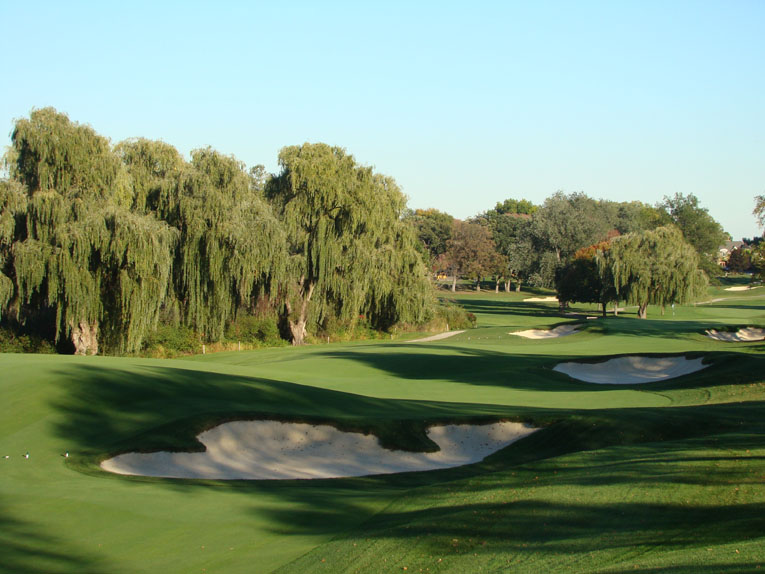
Foster is especially pleased with how this forward fairway bunker was re-introduced into play. Built into a dominant ridge that cuts across the fairway, it plays even bigger than it looks as the gnashing of teeth indicates from those that see the land kick their tee balls into it!

At 4,400 square feet, the eighth green represents the smallest target on the course. It is best approached from the right side of the fairway which is of course where and why Alison placed two bunkers.
Ninth hole, 450 yards; Returning to the clubhouse, the ninth feels like the Home hole it once was! On opening day in 1927, this bruiser was the eighteenth. Originally, the tee was left of the eighth green in a bog. Both access and maintenance proved problematic and necessitated a move well right. Though Alison didn’t oversee the moving of the tee, the happy result was the creation of a true dogleg, the only one on this side.
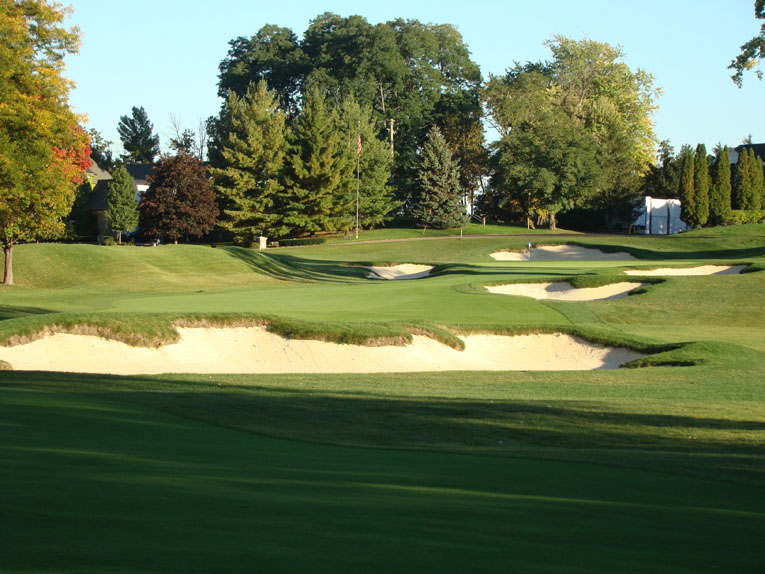
Today’s hole plays as a dogleg right off the tee while the handsome second shot still lines up just as Alison intended.
Eleventh hole, 445 yards; At least one modern architect holds as ideal a right fairway bunkers 265 yards from the tee and left ones 285 yards away as a draw goes farther than a fade. Golden Age designers would scoff at such a formulaic approach. Here, the landforms dictated that the right fairway bunker be well ahead of the left.
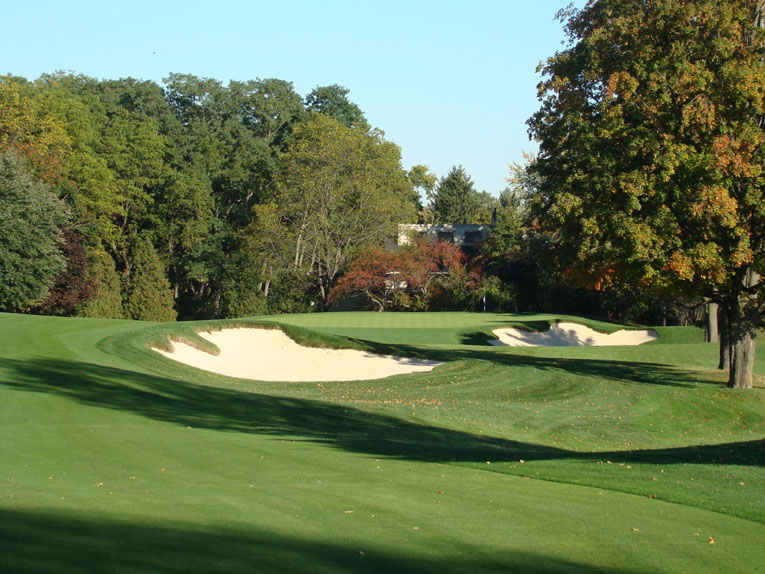
The eleventh fairway elbows right around this beautifully positioned Alison bunker 175 yards from the green.

Alison’s green pads are tall which means that his greenside bunkers are deep, such as the one above at the eleventh. Famous for being penal, his bunkers become known as ‘Alisons’ in Japan. Despite continued improvements in the sand wedge over many decades, Alison’s bunkers are still best avoided.
Thirteenth hole, 195 yards; The rectangular block of 42 acres on the south side of the road required that the holes would run along an east/west axis. So be it. The one exception is the one shot thirteenth which lies perpendicular and it’s easy to imagine that Alison found this hole early in the routing process, so perfect for golf is the fourteen foot depression between tee and green. Since the long one shot seventh, there has been little respite from a series of challenging holes. According to a 1955 article in upstate New York’s Tonawanda News, ‘Speaking of golf, Gene Sarazen purposefully blew a putt on the 18th green of Detroit’s Orchard Lake course. He was two feet away from the cup with his second shot, so he knocked the ball to the side and then flipped it in. He played it that way because he had 17 straight fours. ‘I never had played a round where I had 18 fours in a row,’ Stocky Gene grinned. ‘I decided it was getting late, and if I was ever going to do it, now was the time.’ Imagine blowing a birdie on purpose!’ Imagine that indeed – Sarazen bogeyed all four one shot holes at Orchard Lake! Conversely, he birdied the three par 5s to tidy up his card.
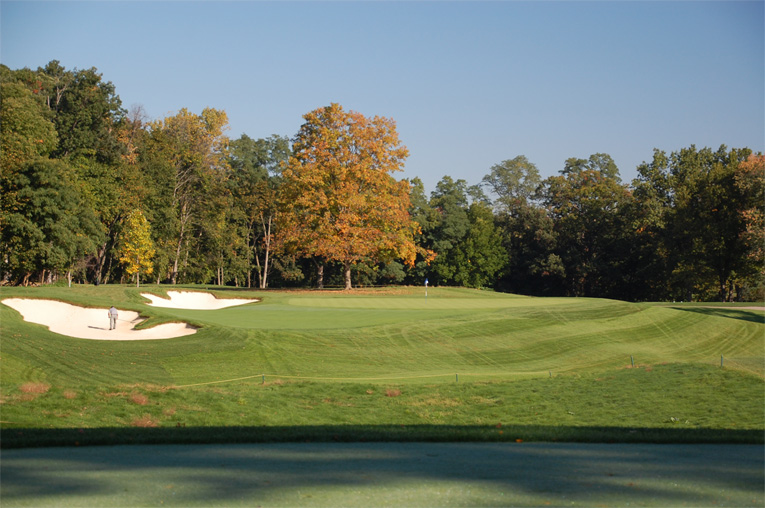
No wonder Alison accepted this project and then devoted so much personal time to it. Natural depressions like this one are the envy of most private clubs in the greater Detroit area.
Fifteenth hole, 430 yards; Foster notes, ‘If you lived in an intellectual bubble, the task of any restorer would be to make each green exactly as the architect had it.’ Yet, that’s just not the real world, that’s fantasy land. In the case here, the green had been severely altered to feature two tiers that had nothing to do with Alison. Enchanted with the virtues of the seventeenth hole, Foster pulled the green ten yards left (away from the road that bisects the property) and built an entirely new one. It fits perfectly and best, it brings directly into the line of play an Alison bunker that was once well left.
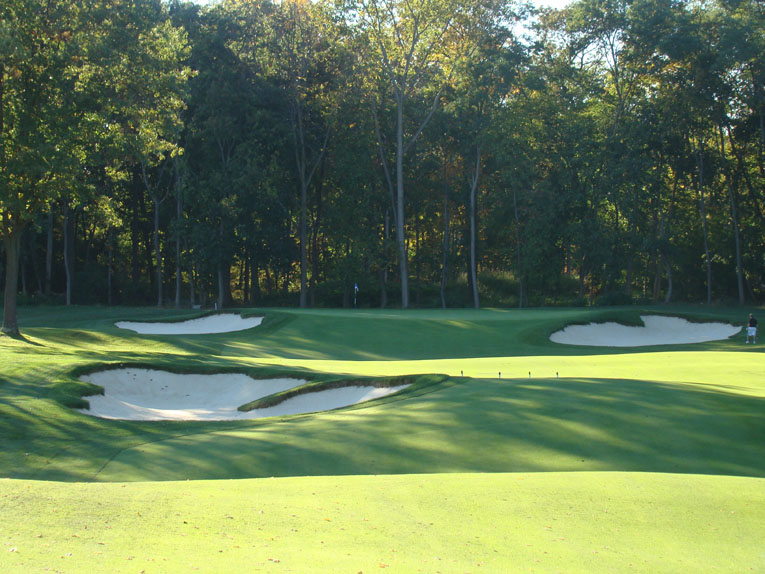
For all the world, the fifteenth feels like an Alison hole. A key indicator of the success of the restoration is that the entire course now feels as one homogeneous fabric. Not only is there no hint of Bill Diddle’s work in the 1960s but there is no evidence that Keith Foster was here either! As Foster says, mission accomplished.
Sixteenth hole, 155 yards; Scroll back through the photographs of the one shot holes and their uniqueness is what jumps out. They ‘box the compass’ which matters when you are in the windy Great Lakes environs and are physically quite distinct. Think about it: the Redan-like third, the magnificently long seventh, the thirteenth’s crater, and the walled-off teasing short sixteenth.
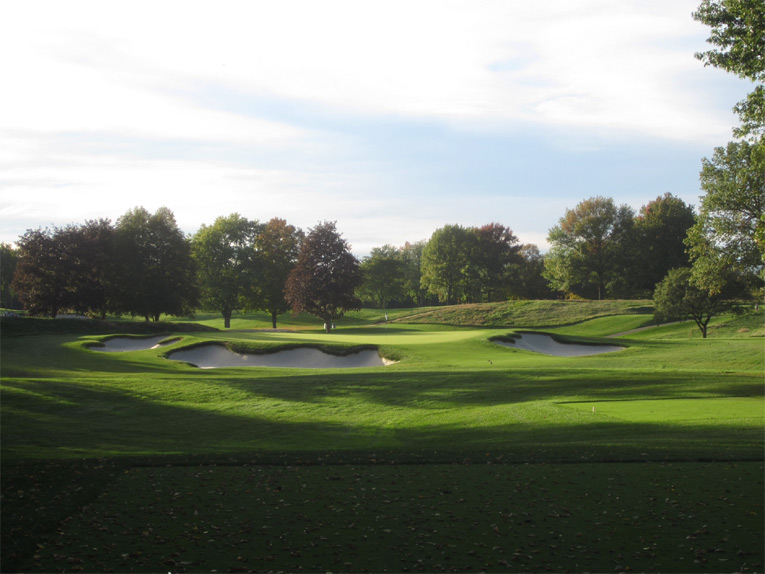
Carry it too deep onto this well –bunkered classic short hole and the tilt of Alison’s green becomes a major impediment to par. McMaster’s 2013 work in establishing fescue in selective areas such as back right of this green will pay off handsomely in the years to come.
Seventeenth hole, 380 yards; Certainly among Alison’s best, the seventeenth is the favorite of many a member. All the elements are present that make Orchard Lake special: a convoluted fairway where level stances are elusive, artistic fairway bunkers that extract ½ stroke penalties, and a well placed, formidable green atop a hillock.
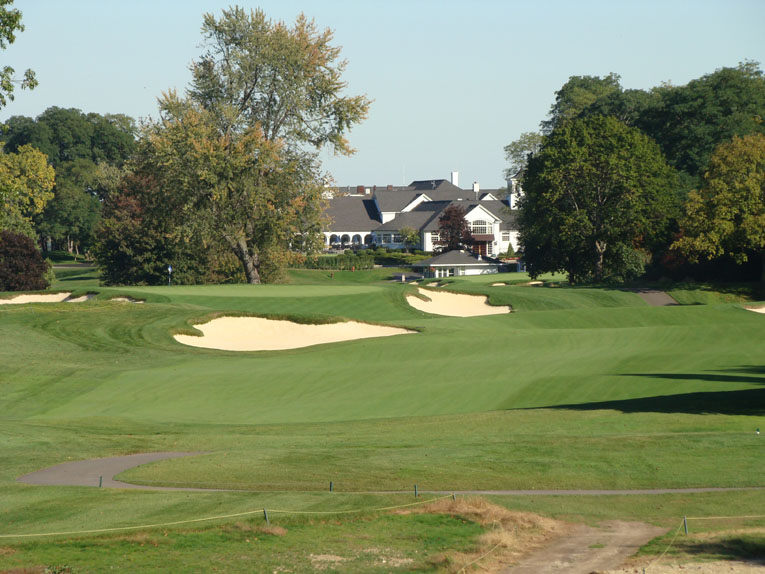
As seen from the back tee, the last two holes head east back to the clubhouse and make for a rousing finish.
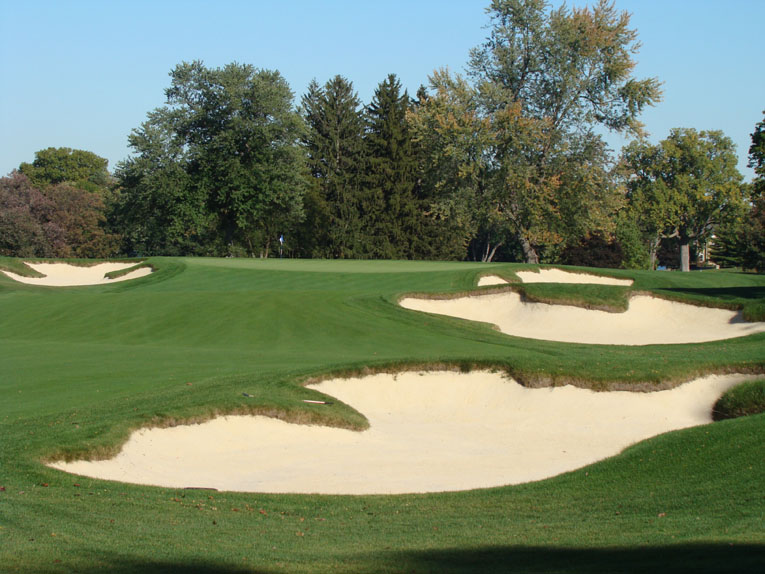
The appeal of the approach shot is timeless: Can the golfer carry the rise and keep his approach shot below the hole on the tilted green?
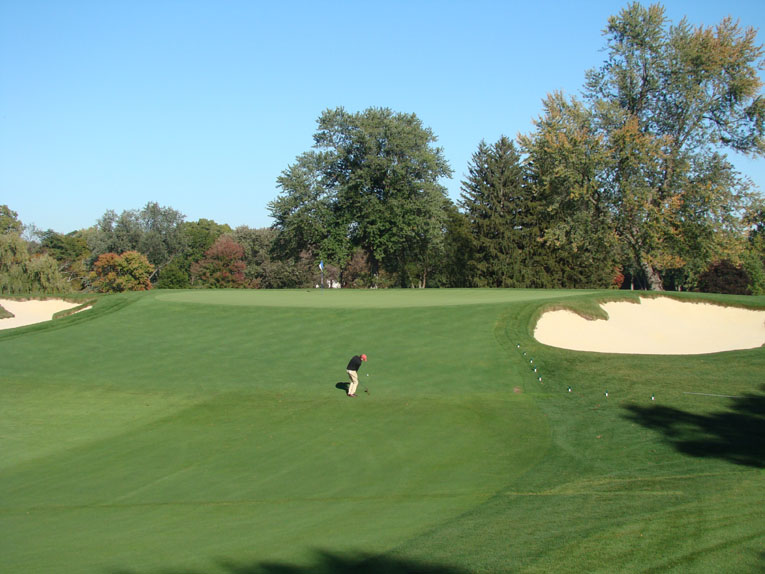
Back to the drawing board: This golfer’s approach landed a foot on the green, jumped forward, tittered and then rolled back down the slope. The recovery pitch from a tight lie might be more unnerving than the full approach shot.
Eighteenth hole, 375 yards; Golf was played with hickory clubs for the first several years at Orchard Lake and the course was obviously built with that in mind. Given that the course measures over 500 yards longer today than when it opened, Orchard Lake has compensated for changes in technology. Yet some holes adjust better than others and the eighteenth is a cracker even if it is played with a three wood and short iron. Frankly, it wouldn’t have played much differently in Alison’s day. Then as now, the severely canted right to left green is ample defense.
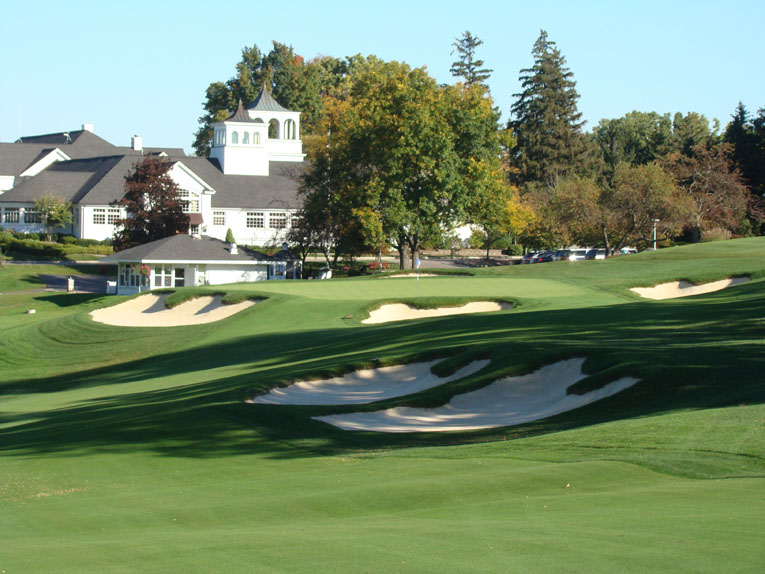
Alison was a strong player and Foster believes that his courses reflect that ability. His greens almost always feature broad slopes in contrast to the straight- hitting Walter Travis who built intricate, almost delicate greens. Alison’s right to left swoop on the Home green solicits many a 3 putt at the most ruinous of times.
Additional reading on Alison can be found throughout GolfClubAtlas.com, notably in the Kirtland Country Club and Milwaukee Country Club profiles and with Tom MacWood’s excellent piece on Alison’s work in Japan. In that article, MacWood nicely sums up Alison’s approach to bunkers:
All these influences contributed to the Alison style, a style that did feature very deep bunkers. Not only were his bunkers deep – both greenside and fairway – they were also very large in scale. Alison’s greenside bunkers were frequently as large as the greens they guarded. He often elevated the green well above the approaching fairway or tee;, bunkers were then cut well below the elevation, in effect increasing their depth. Fairway bunkers were placed against or below mounding, which also increased their effective depth. And he was not opposed to an occasional forced carry — usually with bunkers set at a diagonal, allowing for choice and rewarding the bold play.
Suffice to say, that from his partnership with Colt, to his time in United States that included work at Pine Valley, to building epic courses in Japan, the Netherlands, and ultimately South Africa where he died in 1952, Alison left a global legacy that few can match.
Better than almost any architect before or since, Alison embraced the appeal of teeing off with a ball on the first tee and holing out with it on the eighteenth green. Doing so gives any golfer a great sense of satisfaction. While Alison created fierce hazards, they were rarely of the do-or-die variety. According to MacWood, Alison wrote in a letter, ‘Water is a bad feature in that the ball cannot be played from it, and in consequence it does not test the golfer’s skill.’ He gave all golfers plenty of room to operate but an advantage to the better player who successfully took the bolder line.
Without water hazards, Orchard Lake serves as the perfect place to learn the game of golf, develop a deep appreciation for it and then grow gracefully old with your clubs and dignity still intact. Be it a grandson of 12, granddad at 76, or the tiger, every golfer can have fun on a course like Orchard Lake. This newly restored Alison joins the likes of Milwaukee and Kirtland as the best examples of this master architect’s work in the United States. The secret is out – the course that Sarazen loved is back for all to appreciate.


